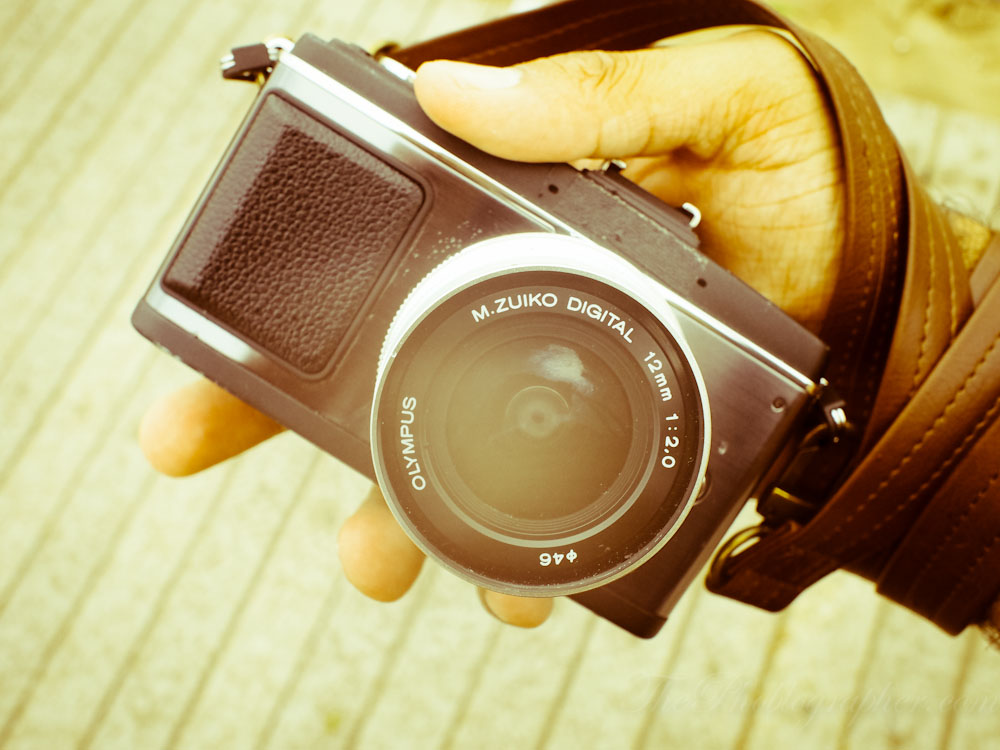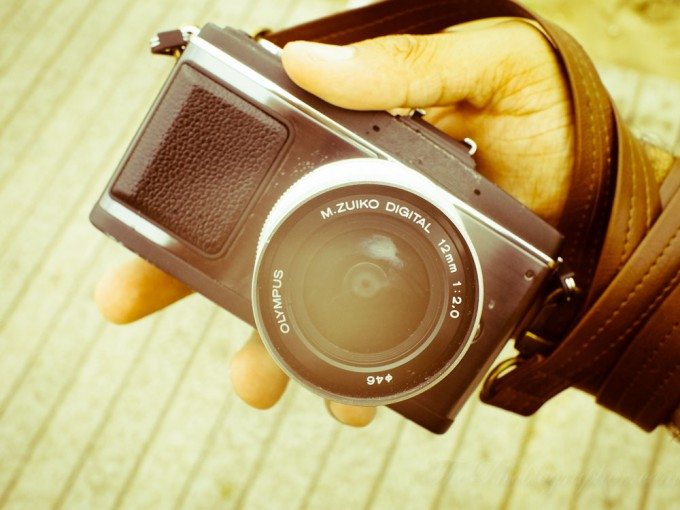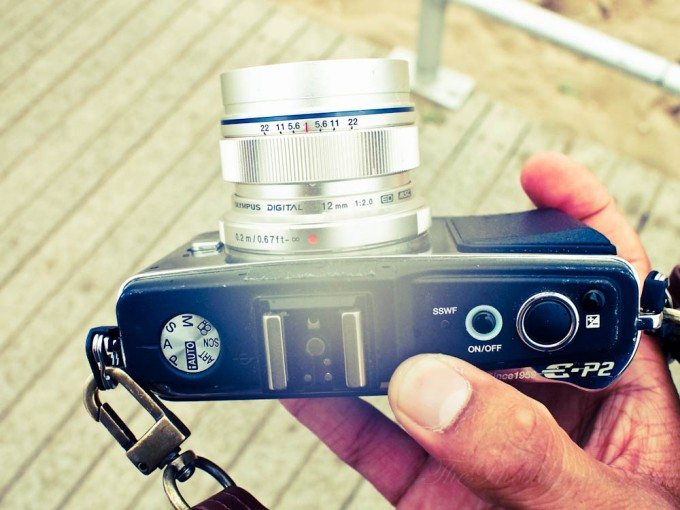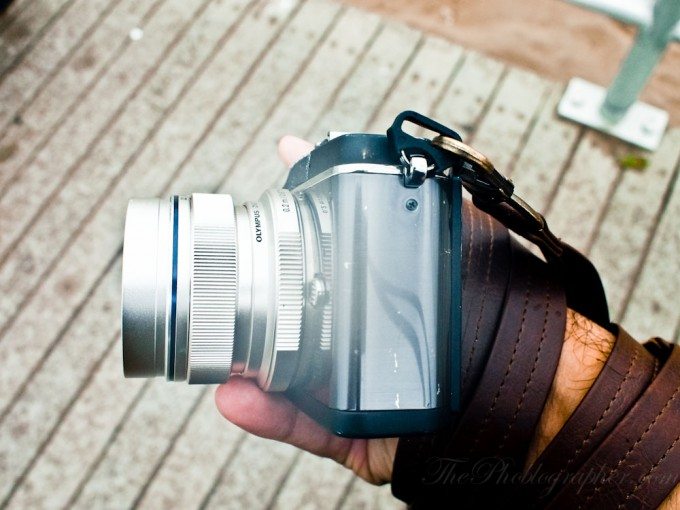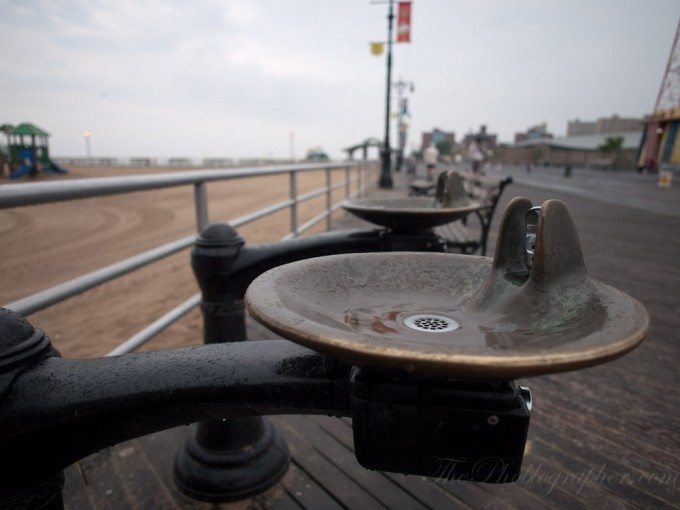After our review of the Olympus EP3 and 12mm F2, requests came in asking about how the lens performs on older cameras. We’ve already seen that it performs very well on the Olympus EP3 (also called the E-P3, EP-3, and EP 3). For some real world testing, I took the Olympus 12mm F/2 and mated it with the Olympus EP2 while walking around Coney Island, NY—in the rain! So did the dynamic duo survive?
Looks
When on the Olympus EP-2, the 12mm F/2 feels extremely light—which won’t slow you down when it comes to focusing and composing your image. But don’t let that fool you though, it still also feels like a serious lens meant to do lots of hard work. It certainly contrasts with the rest of the black body; even more so than the 17mm F/2.8. The metallic silver finish looks more like the metal around the camera’s hot shoe than anything.
One needs to keep in mind though that this is still quite a small lens. It will remind you a bit of the old Leica lenses or M42 mount glass from years ago. As I went through the NYC Subway system and around Coney Island though, no one seemed to be alarmed when I took their photos. That should be an important little tidbit to street photographers that always try to maintain their stealthy ninja ways.
If anything, putting gaffer’s tape on the Olympus logo made the camera looks more and more like an old school film camera. Plus it was small, so it didn’t alarm anyone.
Autofocus
As you can see in the video above, the lens doesn’t focus anywhere as fast as it does on the Olympus EP-3. With the EP-2, the best way to focus is to use the center area and recompose—the way that lots of old school pros do it! However, that doesn’t at all take full advantage of the lenses new MSC design—which allows for focusing speeds faster than a DSLR.
Still though, it’s better than manually focusing your lens. That’s not to say that manually focusing this lens is a drag though—I’m just saying that it may be better with the electronic viewfinder or for videography.
Due to the slower autofocusing though, you’ll need to plan ahead a bit when taking candid photos. This all has to deal with your approach to subjects that you’re photographing. Be warned that you can’t just go right up to someone, tap the screen and move on the way you can with the EP3.
Image Quality
As with the Olympus EP3, one really can’t complain about the image quality at all with this lens. The color rendering is very true to life and unless you’re very close up, there is almost no distortion. In fact, I daresay that the colors are the most life-like I’ve seen of any lens in the Micro Four Thirds system. Additionally, any vignetting wide open can easily be taken care of in post-production unless you don’t mind it.

On the camera, it has a 24mm equivalent field of view: which is once again one of the ideal focal lengths for street photography. At reasonable distances away from your subject, you’ll have lots of space to focus the lens and then recompose your image based on the rule of thirds. It’s so nice to be able to do this with a fast prime lens on the Micro Four Thirds camera system.
When objects are closer up, the lens tends to render them so sharply that the images look almost 3D. Zeiss calls this micro-contrast with their lenses, but it isn’t a feature that Olympus has talked about. For the documentarian or photojournalist looking for a smaller camera so as not to alert anyone, this lens on a Micro Four Thirds body may be something to consider due to small size coupled with the image quality that it produces.
What’s even more shocking is that Olympus managed to create a 12mm lens with such a fast aperture. Sure, you pay the cost for it, but when you think about it and look at the images it’s worth every penny. With this lens attached, you may even probably think twice about using the 17mm F/2.8.
Even though there wasn’t much sun, I tried to make the lens flare when pointing it straight towards other light sources. Not only did I try this outside, but also in the NYC subway where there was a greater chance of it. Indeed, it was super hard to make it flare. For photographers that like that look, you may want to look somewhere else.

When attached to the EP2, the lens tends to resolve lots of detail. In fact, you don’t even need to blow your images up to 100% to see them. Simply import them into Lightroom 3 and you’ll be shocked to see what can be done.
Sharpness
You can see a full sharpness test in my full review, but either way it should be noted that the lens is superbly sharp when the camera is shooting at lower ISO settings. For a 12MP sensor, I’m actually quite amazed. I’ve used the Nikon D700, D300s and other 12MP cameras and I haven’t been able to see such amazing sharpness even despite using the good Nikon lenses. The fact that it’s beating even the D300s even astounds me.
To make the best of this lens’s sharpness, one needs to realize that they are dealing with the older focusing system. With that said, moving subjects absolutely need to be shot using tracking continuous AF and still subjects need to be shot with single focus. While this may sound like common sense, it is important because many photographers (myself included) tend to leave their camera’s focusing on one setting.
Bokeh

As stated earlier on in the full review, I really wish that the bokeh were creamier. Indeed, it looks like everything is just softly out of focus. That’s because of the fact that it is actually a 12mm lens. At that focal length, it’s tough to get most things out of focus.
Or is it?

This photo was captured on the pier. Some fishermen were catching fish and selling them right out of the water! They caught this baby shark. I hadn’t seen one in years so I decided to get up close and personal with it for a picture. The shark is very sharply in focus and everything else fades more and more out of focus as it is further away.
The bokeh here still isn’t creamy enough for me, but I have to admit that it still looks pretty nice. It isn’t harsh at all, which is even more important.
Perhaps one of the reasons why Olympus didn’t make the bokeh creamier could have been that the Pen cameras have a Diorama art filter included. Said filter gives everything a tilt-shift perspective. If combined with the lens being shot wide open, everything may look like total mush. Note that the image above wasn’t shot with the filter, it is just another example of the bokeh quality of this lens.
Still though, it should once again be noted that the bokeh for a lens like this is still quite good though it could be better.
Conclusions
So is a lens like this really worth it? Absolutely! Consider the following:
– It’s 12mm and F/2. There isn’t much distortion or vignetting either.
– It has manual focus via the ring.
– The build quality is superb.
– It focuses quickly.
– It is damned sharp.
– The color rendering is lovely and lifelike.
– It’s a small lens.
Sure, it may be a tad bit expensive, but when you really think about it and use it, it’s worth every penny and will probably find a permanent home on your camera. If you’re interested in the lens you can check out these links:
Please Support The Phoblographer
We love to bring you guys the latest and greatest news and gear related stuff. However, we can’t keep doing that unless we have your continued support. If you would like to purchase any of the items mentioned, please do so by clicking our links first and then purchasing the items as we then get a small portion of the sale to help run the website.


